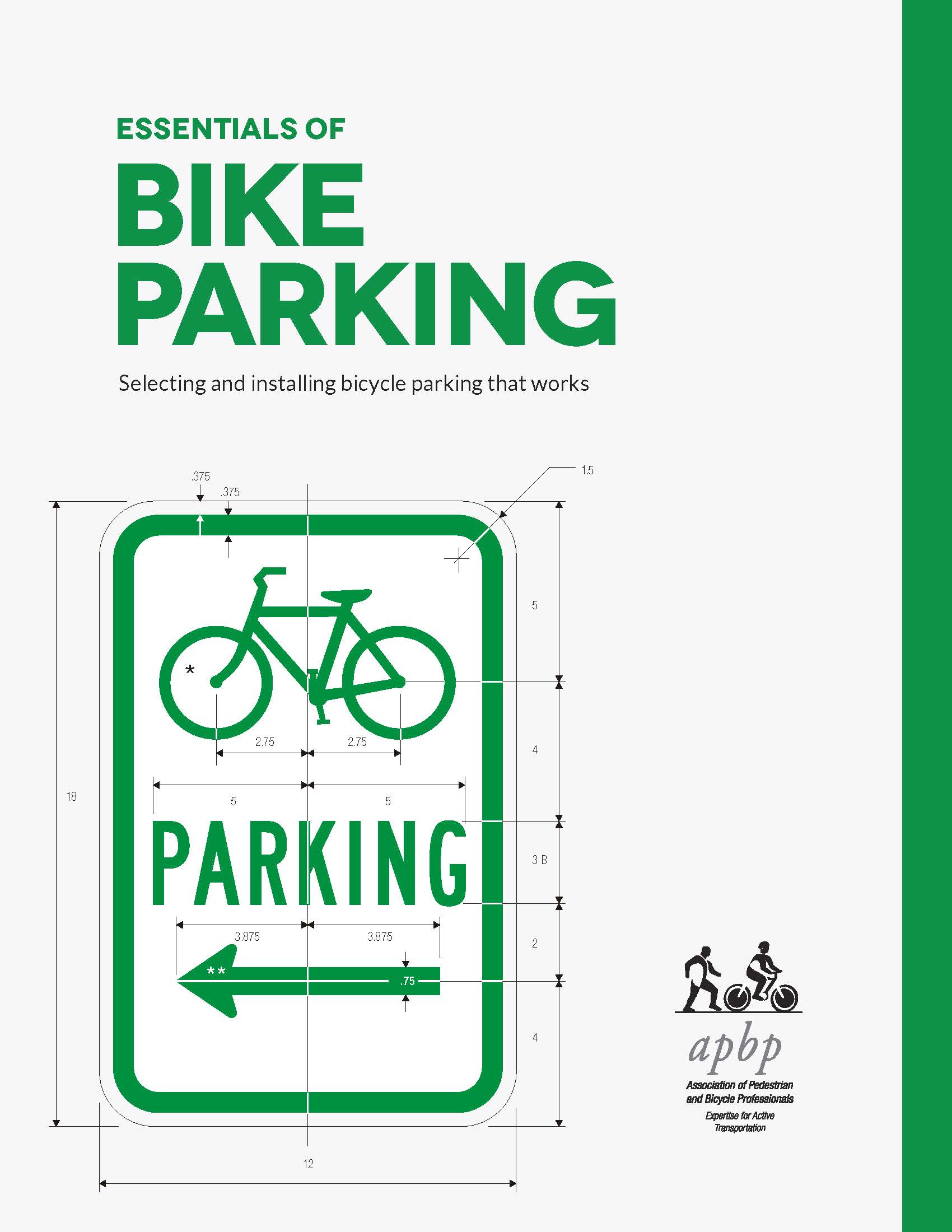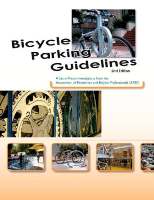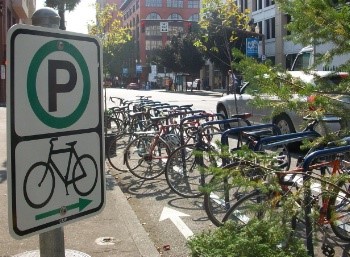Bicycle Parking Solutions
APBP provides a full range of solutions for bicycle parking.
Want permission to use one of APBP's bicycle parking documents? Contact us with your request.
Essentials of Bicycle Parking: Selecting and Installing Bicycle Parking That Works (2015)
Click here to download
 APBP prepared Essentials of Bike Parking for people planning to purchase or install bike parking fixtures on a limited scale. It is a brief overview of APBP’s Bicycle Parking Guidelines, 2nd Edition. This 12-page guide covers the following topics: APBP prepared Essentials of Bike Parking for people planning to purchase or install bike parking fixtures on a limited scale. It is a brief overview of APBP’s Bicycle Parking Guidelines, 2nd Edition. This 12-page guide covers the following topics:
• Site planning for short- and long-term parking
• Installation
• Bicycle rack selection--including performance criteria, rack styles, and materials and coatings
• Placement and spacing
This guide may be freely distributed and used for any non-commercial purpose.
Bicycle Parking Guidelines, 2nd Edition (2010), PDF Download
Click here to purchase the guide ($20 for APBP members, $45 for non-members)
 APBP's Bicycle Parking Guidelines, 2nd Edition, is a comprehensive resource for best practices for bike parking. Widely adopted in local policies and ordinances, the guide includes general principles and definitions of terms; elements of a good rack or locker, including specific performance criteria; guidance for short- and long-term parking, event parking, in-street parking, and bicycle transit centers; maintenance best practices; sample site plans and diagrams to help avoid blunders in rack and locker placement; sample quantity requirements for bicycle parking to meet need by land use; and a worksheet for programming bicycle parking for a building or cluster of buildings. APBP's Bicycle Parking Guidelines, 2nd Edition, is a comprehensive resource for best practices for bike parking. Widely adopted in local policies and ordinances, the guide includes general principles and definitions of terms; elements of a good rack or locker, including specific performance criteria; guidance for short- and long-term parking, event parking, in-street parking, and bicycle transit centers; maintenance best practices; sample site plans and diagrams to help avoid blunders in rack and locker placement; sample quantity requirements for bicycle parking to meet need by land use; and a worksheet for programming bicycle parking for a building or cluster of buildings.
Bicycle Parking Webinar Series
Click here to purchase  This 4-part webinar series covers all aspects of bicycle parking, beginning with an overview and discussion of basic principles, followed by three focused discussions on applications and techniques used by different entities to accommodate bicycle parking demand (municipal, transit and campus). Intended for both the experienced agency manager and those new to developing bike parking solutions, examples are drawn from across North America to show how a comprehensive approach to parking can help achieve both public and private goals while integrating with other land use, transit and sustainability efforts. This 4-part webinar series covers all aspects of bicycle parking, beginning with an overview and discussion of basic principles, followed by three focused discussions on applications and techniques used by different entities to accommodate bicycle parking demand (municipal, transit and campus). Intended for both the experienced agency manager and those new to developing bike parking solutions, examples are drawn from across North America to show how a comprehensive approach to parking can help achieve both public and private goals while integrating with other land use, transit and sustainability efforts.
|

 APBP prepared Essentials of Bike Parking for people planning to purchase or install bike parking fixtures on a limited scale. It is a brief overview of APBP’s Bicycle Parking Guidelines, 2nd Edition. This 12-page guide covers the following topics:
APBP prepared Essentials of Bike Parking for people planning to purchase or install bike parking fixtures on a limited scale. It is a brief overview of APBP’s Bicycle Parking Guidelines, 2nd Edition. This 12-page guide covers the following topics:  APBP's Bicycle Parking Guidelines, 2nd Edition, is a comprehensive resource for best practices for bike parking. Widely adopted in local policies and ordinances, the guide includes general principles and definitions of terms; elements of a good rack or locker, including specific performance criteria; guidance for short- and long-term parking, event parking, in-street parking, and bicycle transit centers; maintenance best practices; sample site plans and diagrams to help avoid blunders in rack and locker placement; sample quantity requirements for bicycle parking to meet need by land use; and a worksheet for programming bicycle parking for a building or cluster of buildings.
APBP's Bicycle Parking Guidelines, 2nd Edition, is a comprehensive resource for best practices for bike parking. Widely adopted in local policies and ordinances, the guide includes general principles and definitions of terms; elements of a good rack or locker, including specific performance criteria; guidance for short- and long-term parking, event parking, in-street parking, and bicycle transit centers; maintenance best practices; sample site plans and diagrams to help avoid blunders in rack and locker placement; sample quantity requirements for bicycle parking to meet need by land use; and a worksheet for programming bicycle parking for a building or cluster of buildings. This 4-part webinar series covers all aspects of bicycle parking, beginning with an overview and discussion of basic principles, followed by three focused discussions on applications and techniques used by different entities to accommodate bicycle parking demand (municipal, transit and campus). Intended for both the experienced agency manager and those new to developing bike parking solutions, examples are drawn from across North America to show how a comprehensive approach to parking can help achieve both public and private goals while integrating with other land use, transit and sustainability efforts.
This 4-part webinar series covers all aspects of bicycle parking, beginning with an overview and discussion of basic principles, followed by three focused discussions on applications and techniques used by different entities to accommodate bicycle parking demand (municipal, transit and campus). Intended for both the experienced agency manager and those new to developing bike parking solutions, examples are drawn from across North America to show how a comprehensive approach to parking can help achieve both public and private goals while integrating with other land use, transit and sustainability efforts.